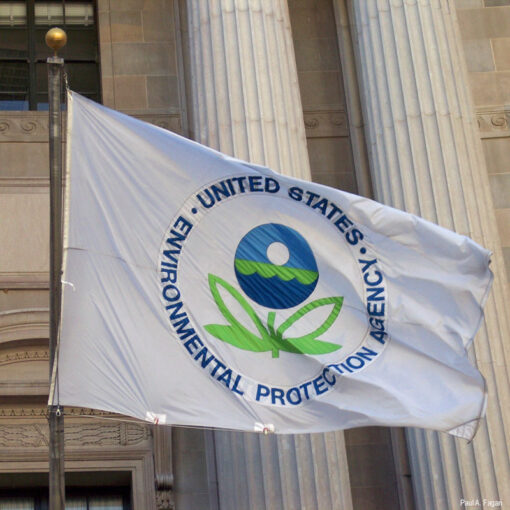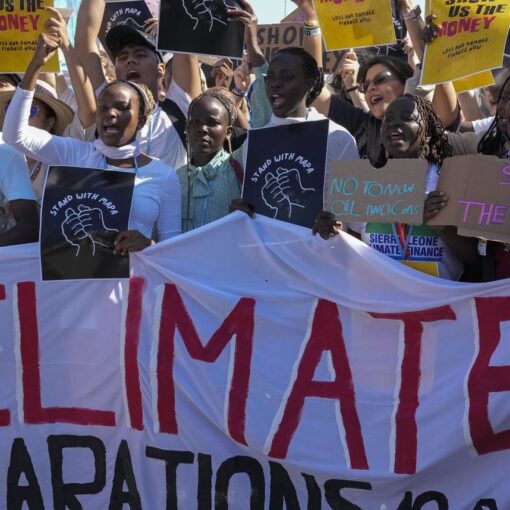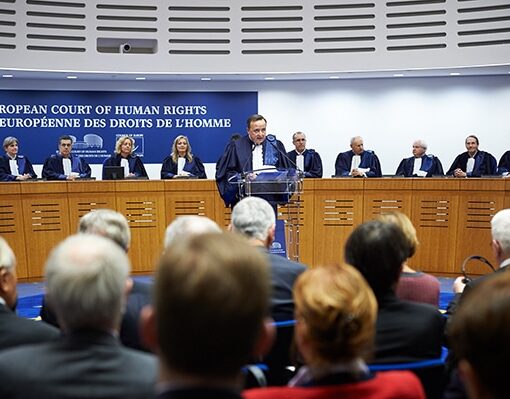This post is part of a new Climate Law Blog series, 100 Days of Trump 2.0, in which the Sabin Center offers reflections on the first 100 days of President Trump’s second term across a variety of climate-related topics. To read other posts from the series, which will roll out over the course of this week, click here.

The second Trump administration’s efforts to roll back the United States’ actions to address climate change began with a barrage of executive orders and presidential memoranda on Inauguration Day, and that onslaught has continued over the subsequent 100 days. Although some of the administration’s early actions to dismantle climate programs quickly ripened into litigation—perhaps most notably the challenges to the purported termination of Inflation Reduction Act (IRA) funding—these first days may actually be a momentary lull in courtrooms before a new influx of cases challenges the climate deregulatory actions that President Trump’s executive orders signal his administration will take.
For example, many pending lawsuits that challenge Biden administration climate actions have been paused while Trump officials fill the agencies and familiarize themselves with the ongoing proceedings. And the relatively small number of non-IRA cases that have been filed against the new administration in the first 100 days largely aim to lay the groundwork for future litigation challenging anticipated regulatory rollbacks or to preserve federal information and tools that plaintiffs view as critical to continue their own efforts to address climate change. This post highlights trends seen in the first 100 days in non-IRA cases, tracked in the U.S. climate litigation database, and looks ahead at what we may see next.
Suspended Challenges to Biden Administration Actions and Concerns About “Purgatory”
Activity in most pending challenges to the Biden administration’s climate regulations and actions was temporarily suspended as Trump agency officials began to implement White House directives to review those actions for potential revocation. With some exceptions, federal agencies formerly defending Biden administration climate actions requested that the cases be held in abeyance to allow new political leadership time to be briefed on the litigation and to determine how to proceed. Courts have generally granted these requests. This has been the case, for example, in cases challenging:
- the U.S. Environmental Protection Agency’s (EPA’s) greenhouse gas emissions standards and guidelines for power plants;
- the Department of Labor’s rule allowing Employee Retirement Income Security Act of 1974 fiduciaries to consider environmental, social, and governance (ESG) factors such as climate change in some circumstances;
- the National Highway Traffic Safety Administration’s fuel efficiency standards for passenger cars, light trucks, and heavy-duty pickup trucks and vans; and
- EPA’s emissions standards and guidelines for oil and gas facilities.
There are, however, some notable exceptions to courts’ general willingness to grant requests to pause climate cases:
- The Supreme Court denied the Acting Solicitor General’s request to hold the briefing schedule in abeyance in a case presenting the question of whether fuel producers have standing to challenge EPA’s granting of a preemption waiver for California’s Advanced Clean Car Program regulations. Oral argument was held on April 23.
- In a fully briefed and argued challenge by regulated companies to an EPA rule implementing the phasedown of hydrofluorocarbons under the American Innovation and Manufacturing (AIM) Act, the D.C. Circuit denied EPA’s motion to hold the case in abeyance. Both the petitioners and the industry groups that intervened to defend the rule opposed the abeyance, contending that the case concerned questions about the constitutionality of the AIM Act that only a court could resolve and that the challenges to the implementation methodology raised issues that would recur and needed resolution.
And in cases in which red states, energy companies, and other parties challenged the U.S. Securities Exchange Commission’s (SEC’s) climate disclosure rule, the Eighth Circuit granted a motion to hold the case in abeyance, but it was blue states who had intervened to defend the rule—not the SEC—who requested the abeyance. The parties challenging the rule opposed the abeyance and argued that the rule was a “sword of Damocles” hanging over them and that abeyance would leave the rule in “purgatory.”
The SEC rule challengers’ concern regarding the rule remaining in “purgatory” while the case is held in abeyance is probably well-founded. It is certainly true that the process of rescinding regulations under the Administrative Procedure Act takes time. And even where the direction of the administration may seem clear and efforts to repeal a regulation are underway, there can still be unanticipated outcomes. For example, in November 2016, the Obama administration’s Bureau of Land Management (BLM) promulgated a regulation to reduce waste of natural gas from venting, flaring, and leaks during oil and natural gas production activities on public and Tribal lands. Red states and industry trade groups immediately challenged the rule. The first Trump administration delayed and then repealed portions of the rule, but these actions were blocked or vacated by federal district courts in California. After the repeal of the 2016 rule was vacated, a federal district court in Wyoming vacated the 2016 rule itself in October 2020. Environmental groups’ and two blue states’ appeals from the October 2020 decision were still pending when the Biden administration BLM adopted a new waste prevention rule in April 2024. In August 2024, the Tenth Circuit Court of Appeals then dismissed their appeals as moot and vacated the October 2020 decision vacating the 2016 rule. Meanwhile, a federal district court enjoined enforcement of the Biden rule in September 2024, and the government’s appeal of the injunction is being held in abeyance.
This eight-year saga is an extreme example of the litigation uncertainty created by presidential transitions. But it is part of the context as federal agencies and the challengers and defenders of Biden-era climate actions determine their next moves. Whether the Supreme Court’s Loper Bright decision, which vests authority to interpret statutes more squarely in the courts and gives agencies less wiggle room to change interpretations over time, could perhaps result in this period of “purgatory” being less lengthy remains to be seen. And whether President Trump’s exercise of emergency authorities and assertion of power to repeal regulations without going through notice-and-comment procedures simply overrides procedural requirements to create an entirely new regulatory context is very much an open question (more on that below).
Dismissal of “Moot” Cases
Some of the Trump administration’s reversals or anticipated reversals of Biden policies have already led to the voluntary dismissal of cases challenging those policies:
- Red states challenging the Biden administration’s pause on exports of liquefied natural gas and the U.S. Department of Energy agreed to the dismissal of the lawsuit as “moot” after President Trump reversed the pause in his “Unleashing American Energy” Executive Order.
- The Fifth and Sixth Circuits granted the Trump administration’s motions to voluntarily dismiss the government’s appeals of district court decisions holding that the Federal Highway Administration lacked authority for its rule requiring states to set declining targets for carbon dioxide emissions from on-road mobile sources (and, in the case of the Western District of Kentucky decision on appeal at the Sixth Circuit, also holding that adoption of the rule was arbitrary and capricious). The Department of Transportation said it would “continue to consider what further administrative steps may be appropriate as to the challenged final rule.”
In these cases (unlike in the challenge to the SEC disclosure rule), no parties had intervened to defend the Biden-era actions.
Repositioning
At least a couple of cases tracked in the Sabin Center’s U.S. climate litigation database appear to show litigants repositioning themselves to adapt to the new administration.
In Association of American Railroads v. Randolph, the California Air Resources Board (CARB) seems to have decided, at least for the time being, to withdraw a rule regulating locomotive emissions. The lawsuit, brought by railroad industry groups, had been held in abeyance since September 30, 2024, awaiting a determination by EPA on which portions of the regulation would require EPA authorization under the Clean Air Act and whether to grant such authorization. In January, prior to President Trump’s inauguration, CARB withdrew its request for EPA authorization. In April, CARB agreed to propose withdrawal of the rule, with industry groups agreeing to voluntarily dismiss their case if the repeal is approved by May 30, 2026. The parties, including environmental group intervenors, also agreed “to hold a series of working groups to discuss potential ways to reduce emissions from rail activities, on a voluntary basis, in the State of California.”
A different sort of repositioning may have happened in a new lawsuit brought by timber industry plaintiffs to challenge the U.S. Department of Agriculture’s Southeast Alaska Sustainability Strategy, which the Biden administration touted as important for protecting large old-growth trees in the Tongass National Forest that were “critical for carbon sequestration, addressing the climate crisis and maintaining the productivity and health of the region’s fisheries and fishing industry.” The Alaska Forest Association—which in 2022 was named as a recipient of a $275,000 grant under the Strategy to “[a]dvance information and technology for a young-growth forest products industry and help ensure a successful transition to young-growth forest management that sustains the industry and strengthens local economies in Southeast Alaska”—filed a lawsuit with two other timber industry plaintiffs in March challenging the Strategy as unlawful and arbitrary and capricious.
Early Climate Cases Against the Trump Administration
As of the hundredth day, only a handful of lawsuits have been filed that directly challenge the second Trump administration’s actions to dismantle efforts to address climate change.
Two of those lawsuits are aimed at preserving public access to information about climate change, its impacts, and tools to address it:
- In one case, Sierra Club v. EPA (filed in the U.S. District Court for the District of Columbia), four organizations have asked the court to order five federal agencies to restore webpages that provided environmental justice and climate change information. The agencies took down the websites after President Trump’s inauguration. The removed websites include the Federal Emergency Management Agency’s Future Risk Index, which the plaintiffs alleged “was an interactive mapping tool that provided projected economic losses due to climate change at the county level, based on different greenhouse gas emission scenarios and environmental hazards (coastal flooding, extreme heat, wildfire, hurricanes, and drought).” The plaintiffs said the tool “provided free, one-of-a-kind information about how much climate change is likely to cost communities in the United States.”
- In another case, Northeast Organic Farming Association v. U.S. Department of Agriculture (filed in the Southern District of New York), nonprofit organizations have challenged the U.S. Department of Agriculture’s (USDA’s) allegedly unlawful “purge” of climate change-focused webpages that provided resources that farmers, landowners, researchers, and others relied on “to understand and combat climate-change-related risks and vulnerabilities, to search for federal funding opportunities, and to assess the efficacy of USDA programs.”
A few lawsuits are more traditional challenges to regulatory or executive action. For example, one lawsuit challenges EPA’s extension of the reporting deadline for 2024 data under the Greenhouse Gas Reporting Rule. (The extension of the deadline followed EPA Administrator Lee Zeldin’s announcement on March 12 that EPA would reconsider the Greenhouse Gas Reporting Program as one of 31 planned deregulatory actions.) In Alaska, plaintiffs have filed a new lawsuit and are attempting to revive an old lawsuit contesting President Trump’s authority to revoke the withdrawal of Outer Continental Shelf lands from oil and gas leasing.
The final category of early climate change cases against the Trump administration are Freedom of Information Act lawsuits. These cases seek to compel the disclosure of otherwise nonpublic information about policy decision-making in the Trump administration—information that can potentially be used (eventually) in challenges to actual policies. Information sought in these lawsuits relates to the reconsideration of EPA’s 2009 endangerment finding for greenhouse gases under the Clean Air Act (see here, here, and here) and agency action plans to identify regulations that are “unduly burdensome” to development and use of domestic energy resources (see here).
Future Battles
The volume of climate change-related cases filed against the Trump administration is likely to increase soon, particularly because—as noted in another 100 Days of Trump 2.0 post—President Trump has asserted broad authorities to take actions to roll back Biden administration policies and to speed energy projects that involve coal, oil, and natural gas without the need for adherence to procedures ordinarily followed by agencies. Examples of cases we are likely to see soon include:
- One or more lawsuits challenging the U.S. Department of Energy’s (DOE’s) repeal, effective May 15, of the regulatory definition of “showerhead” under the Energy Policy and Conservation Act. DOE characterized the repeal as “nondiscretionary” because President Trump declared in his Executive Order on “Maintaining Acceptable Water Pressure in Showerheads” that “[n]otice and comment is unnecessary because I am ordering the repeal.” This assertion of presidential power is all but certain to be contested.
- Lawsuits challenging expedited reviews of fossil fuel energy projects under emergency permitting procedures announced by the U.S. Department of the Interior on April 23, 2025. The procedures provide for, among other things, a 28-day period for preparation of an environmental impact statement. As discussed in more detail here, projects approved under these procedures are likely to face challenges to the underlying assertion of emergency circumstances, as well as claims that the approvals themselves are arbitrary and capricious.
- Lawsuits challenging Trump administration actions to derail clean energy projects. The Interior Department’s emergency permitting procedures do not apply to wind, solar, or energy storage projects, and, in fact, Secretary of the Interior Doug Burgum has directed the Bureau of Ocean Energy Management to order construction to cease on the already-approved Empire Wind offshore wind project until additional review is completed to address “serious deficiencies.” The project’s developer complied with the order but has said it is considering its legal remedies, including appeal of the order.
Another type of climate lawsuit that could be coming soon are suits in which the U.S. Department of Justice challenges state and local climate laws, regulations, and lawsuits under President Trump’s Executive Order on “Protecting American Energy from State Overreach.” The order directed the Attorney General to identify and take “appropriate action” to stop enforcement of State laws that she identifies as “burdening the identification, development, siting, production, or use of domestic energy resources that are or may be unconstitutional, preempted by Federal law, or otherwise unenforceable.” For more on this executive order, see here.
We will continue to track climate cases brought against and by the Trump administration in the U.S. climate litigation database. You can subscribe to our twice-monthly litigation newsletter here and you can view past litigation updates here.





